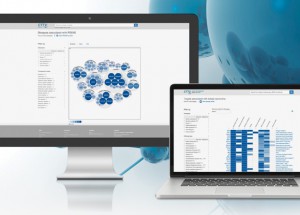
The Centre for Therapeutic Target Validation (CTTV) has launched a new web platform for life-science researchers that helps them identify therapeutic targets for new and repurposed medicines. Today’s launch underscores the CTTV’s commitment to share its data openly to benefit the broader scientific community.
Establishing the validity of an association between a disease and biological target for a drug can be extremely challenging and expensive. To address this challenge, the CTTV, a collaboration between GSK, the Wellcome Trust Sanger Institute and EMBL-EBI, has created a web-based platform (www.targetvalidation.org) that draws on public data resources to help drug discovery. This state-of-the-art web interface will allow researchers to access thousands of target profiles summarising the evidence for the involvement of a specific gene product with a disease.
“The huge growth in human genetic and genomic data has transformed research in a very short space of time, but there is a gap between basic and translational research,” explains Jeff Barrett, Director of the CTTV. “We have learned so much about the links between genes, tissue function and disease, and we need solid partnerships like the CTTV to make sure that knowledge makes it to the people who make medicines. The Target Validation platform is all about enabling communities to work together, making the hand-off from basic research to drug discovery smoother.”
The Target Validation Platform provides a single, robust infrastructure that integrates high-level information from key sources of evidence covering common and rare disease genetics, somatic mutations in cancer, tissue and cellular expression patterns, information mined from published scientific literature, approved drugs, reaction pathways and animal models. Co-designed with biologists, it is easy to search by target, disease or therapeutic area.
We need solid partnerships like the CTTV to make sure that knowledge makes it to the people who make medicines.
Validating effective targets
“Our ability to identify and validate effective targets can mean the difference between developing a new medicine successfully or wasting valuable time and resources pursuing dead ends,” says Lon Cardon, Senior Vice-President of GSK R&D. “The collaborative work under way at the Centre for Therapeutic Target Validation provides a real opportunity for us to make a profound impact on attrition and, even more importantly, to tackle unexpected pathways for new medicine. The launch of this new open access platform is a major step in how we’ll truly open up the discoveries made through this collaboration to benefit the broader scientific community.”
“We worked very closely with biologists working in different environments to make sure the platform would be both useful and intuitive,” says Ian Dunham, Scientific Director of the CTTV. “Today we’ve launched a service that provides evidence for over 21,800 targets, with more than 8800 structured disease and clinical phenotype terms – but we expect those numbers to grow substantially as we integrate CTTV experimental project data.”
Evidence for over 21,800 targets, with more than 8800 structured disease and clinical phenotype terms.
“The CTTV enables researchers in academia to work with industry, bringing the research bases together in a precompetitive environment to deliver insight into the genomics underlying disease. The databases and analytical methods developed will increase our knowledge of the biological targets of diseases to help advance treatments,” says Professor Sir Mike Stratton, Director of the Sanger Institute.
“The CTTV is already transforming research in drug discovery through its specific integration,” says Ewan Birney, Director of EMBL-EBI. “We are delighted at how CTTV has leveraged the high-quality data from EMBL-EBI, providing integration and visualisation for both commercial and academic users, and we’re looking forward to seeing the community use this platform in earnest.”
The CTTV welcomes anyone who is interested in finding connections between genes and diseases to try the platform and share their feedback.
This article was originally published on EBI News
